View in other NatureServe Network Field Guides
NatureServe
Montana
Utah
Wyoming
Idaho
Wisconsin
British Columbia
South Carolina
Yukon
California
New York
Howell's Gumweed - Grindelia howellii
Other Names:
Grindelia paysonorum
State Rank Reason (see State Rank above)
In Montana, Grindelia howellii is known from over 100 mapped occurrences. However, most populations are small and many occur on roadsides or other similarly disturbed habitat. This habitat preference in conjunction with the short-lived nature of the species means occurrences may drift from place to place or from year to year and as a result many occurrences may be ephemeral. These attributes make determination of population numbers as well as the number of extant populations at any given time difficult to assess.
Invasive weeds are a threat to many occurrences, as the habitat occupied by G. howellii is also favorable for many weedy species. Application of herbicides to control these weeds, especially along roadsides may also have a direct, negative impact.
- Details on Status Ranking and Review
Population Size
Score1 - Moderate: Generally 10,000-100,000 individuals.
Range Extent
Score2 - Regional or State Endemic or Small Montana Range: Generally restricted to an area <100,000 sq. miles (equivalent to 2/3 the size of Montana or less) or Montana contributes 50% or more of the species’ range or populations OR limited to 2-3 Sub-basins in Montana.
Area of Occupancy
Score1 - Moderate: Generally occurring in 11-25 Subwatersheds (6th Code HUC’s).
Environmental Specificity
Score1 - Moderate: Species is restricted to a specific habitat that is more widely distributed or to several restricted habitats and is typically dependent upon relatively unaltered, good-quality habitat (C Values of 5-7).
Trends
Score1-2 - Minor to Moderate Declines:
CommentDeclines have occurred at some historical populations due to habitat alteration. However, the species also occupies roadsides and likely has expanded into these human-created, disturbance habitats.
Threats
Score2 - High: 31-70% of the populations are being negatively impacted or are likely to be impacted by one or more activities or agents, which are expected to result in decreased populations and/or habitat quality and/or quantity.
Intrinsic Vulnerability
Score1 - Moderate Vulnerability: Specific biological attributes, unusual life history characteristics or limited reproductive potential makes the species susceptible to extirpation from stochastic events or other adverse impacts to its habitat and slow to recover.
Raw Conservation Status Score
Score
9 to 10 total points scored out of a possible 19.
General Description
Howell's Gum-weed is a short-lived perennial with stems up to 90 cm in length that are woody at the base and clustered on a taproot. The basal leaves are lance-shaped, broadest toward the tip, and up to 20 cm long. The clasping stem leaves are reduced in size and entire-margined or with shallow, ill-defined teeth. Herbage is resinous and glandular. The stem is glandular-haired and usually has some additional long, soft hairs. Flowering heads are borne in a terminal, open, leafy inflorescence. The numerous, narrow, involucral bracts are resinous and have green, recurved tips. The yellow rays about 1 cm long. Achenes are flared at the top with a few stiff bristles that are easily removed.
Phenology
Flowering in July-August.
Diagnostic Characteristics
This species is very similar to G. nana and G. squarrosa. It is distinguished by having glandular, often hairy, rather than glabrous, stems and lowermost stem leaves that are clasping.
A recent revision of the genus (Adriana and Tortosa 2012) provides information that the name G. paysonorum should have precedence over G. howellii.
Species Range
Montana Range
Range Descriptions
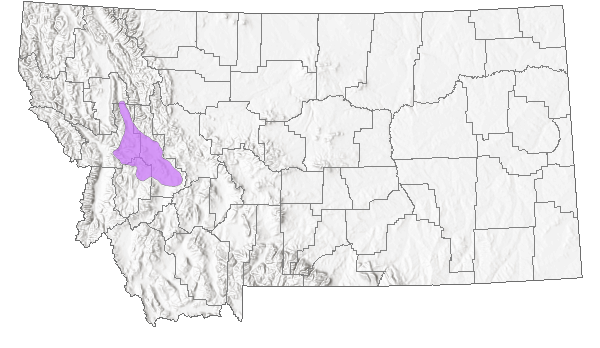
 Native
Native
Range Comments
Regional endemic known from Missoula and Powell counties in Montana and in Benewah County, Idaho.
Observations in Montana Natural Heritage Program Database
Number of Observations: 354
(Click on the following maps and charts to see full sized version)
Map Help and Descriptions
Relative Density
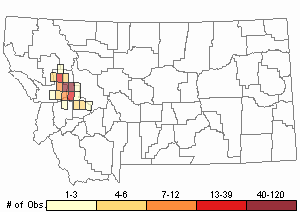
Recency
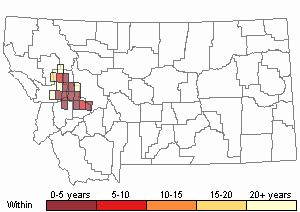
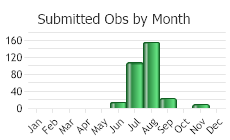
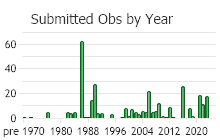
 (Observations spanning multiple months or years are excluded from time charts)
(Observations spanning multiple months or years are excluded from time charts)
Habitat
Vernally moist, lightly disturbed soil adjacent to ponds and marshes, as well as similar human-created habitats, such as roadsides and grazed pastures.
National Vegetation Classification System Groups Associated with this Species
Grassland
Lowland - Prairie Grassland
Wetland and Riparian
Wet Meadow and Marsh
Ecology
POLLINATORS The following animal species have been reported as pollinators of this plant species or its genus where their geographic ranges overlap:
Bombus bifarius,
Bombus fervidus,
Bombus flavifrons,
Bombus rufocinctus,
Bombus sylvicola, and
Bombus occidentalis (Thorp et al. 1983, Williams et al. 2014).
Stewardship Responsibility
Threats or Limiting Factors
STATE THREAT SCORE REASON
Reported threats to Montana's populations of Howell's Gumweed are those that impact its habitat in frequently disturbed areas (MTNHP Threat Assessment 2021). Howell’s Gumweed is a short-lived perennial occupying transitions between grassland and wet meadows and riparian areas. These habitats often coincide with roads, prone to non-native plants colonization and subsequent exposure to controlling agents. Non-native or noxious species are reported to occur at nearly every population. Howell's Gumweed is reported to have a strong negative response to chemical herbicide, and actions intended to control exotic plants may amplify damage to populations in the vicinity. Several populations are presumed lost following road maintenance activity and/or herbicide application. A major population known from genetic analysis to be the core source of surrounding populations, is potentially threated where a re-routed road is proposed. Trampling from road building machinery may have extreme impact to an important population, and the decommissioned section is at risk of eventual mortality if road travel is an important vector of seed dispersal. Other threats include those from recreation, especially motorized activities. Some populations are also located where land-use change for residential development is a concern.
References
- Literature Cited AboveLegend:
 View Online Publication
View Online Publication MTNHP Threat Assessment. 2021. State Threat Score Assignment and Assessment of Reported Threats from 2006 to 2021 for State-listed Vascular Plants. Botany Program, Montana Natural Heritage Program, Helena, Montana.
MTNHP Threat Assessment. 2021. State Threat Score Assignment and Assessment of Reported Threats from 2006 to 2021 for State-listed Vascular Plants. Botany Program, Montana Natural Heritage Program, Helena, Montana. Thorp, R.W., D.S. Horning, and L.L. Dunning. 1983. Bumble bees and cuckoo bumble bees of California (Hymenoptera: Apidae). Bulletin of the California Insect Survey 23:1-79.
Thorp, R.W., D.S. Horning, and L.L. Dunning. 1983. Bumble bees and cuckoo bumble bees of California (Hymenoptera: Apidae). Bulletin of the California Insect Survey 23:1-79. Williams, P., R. Thorp, L. Richardson, and S. Colla. 2014. Bumble Bees of North America. Princeton, NJ: Princeton University Press. 208 p.
Williams, P., R. Thorp, L. Richardson, and S. Colla. 2014. Bumble Bees of North America. Princeton, NJ: Princeton University Press. 208 p.
- Additional ReferencesLegend:
 View Online Publication
View Online Publication
Do you know of a citation we're missing? Achuff, P. L. and L. A. Schassberger Roe. 1991. Weeds and rare native plants in Montana. Proc. Weed Symposium (1991): 18-23.
Achuff, P. L. and L. A. Schassberger Roe. 1991. Weeds and rare native plants in Montana. Proc. Weed Symposium (1991): 18-23. Bartoli, Adriana, and Roberto D. Tortosa. 2012. "Revision of the North American Species of Grindelia (Asteraceae) 1". Annals of the Missouri Botanical Garden. 98 (4): 447-513.
Bartoli, Adriana, and Roberto D. Tortosa. 2012. "Revision of the North American Species of Grindelia (Asteraceae) 1". Annals of the Missouri Botanical Garden. 98 (4): 447-513. Caicco, S. L. 1987. Field investigations of selected sensitive plant species on the Idaho Panhandle National Forest. Idaho Natural Heritage Program, Idaho Department of Fish and Game, Boise, Idaho. 44 pp.
Caicco, S. L. 1987. Field investigations of selected sensitive plant species on the Idaho Panhandle National Forest. Idaho Natural Heritage Program, Idaho Department of Fish and Game, Boise, Idaho. 44 pp. Lesica, P. 1994. The distribution of plant community diversity associated with glacial wetlands in the Ovando Valley, Montana. [Unpublished report.] The Nature Conservancy, Montana Field Office, Helena. 26 pp.
Lesica, P. 1994. The distribution of plant community diversity associated with glacial wetlands in the Ovando Valley, Montana. [Unpublished report.] The Nature Conservancy, Montana Field Office, Helena. 26 pp. Lesica, P., M.T. Lavin, and P.F. Stickney. 2012. Manual of Montana Vascular Plants. Fort Worth, TX: BRIT Press. viii + 771 p.
Lesica, P., M.T. Lavin, and P.F. Stickney. 2012. Manual of Montana Vascular Plants. Fort Worth, TX: BRIT Press. viii + 771 p. Lesica, P., M.T. Lavin, and P.F. Stickney. 2022. Manual of Montana Vascular Plants, Second Edition. Fort Worth, TX: BRIT Press. viii + 779 p.
Lesica, P., M.T. Lavin, and P.F. Stickney. 2022. Manual of Montana Vascular Plants, Second Edition. Fort Worth, TX: BRIT Press. viii + 779 p. Lorain, C.C. 1991. Species management guide for Grindelia howellii (Howell's gumweed) on the Saint Joe National Forest. Idaho Natural Heritage Program Report, Idaho Department of Fish and Game, Boise, Idaho.
Lorain, C.C. 1991. Species management guide for Grindelia howellii (Howell's gumweed) on the Saint Joe National Forest. Idaho Natural Heritage Program Report, Idaho Department of Fish and Game, Boise, Idaho. Pavek, D.S. 1991. Update to the report on the conservation status of Grindelia howellii, a candidate threatened species. Unpublished report to the U.S. Fish and Wildlife Service and the Montana Natural Heritage Program, Helena, Montana 66 pp.
Pavek, D.S. 1991. Update to the report on the conservation status of Grindelia howellii, a candidate threatened species. Unpublished report to the U.S. Fish and Wildlife Service and the Montana Natural Heritage Program, Helena, Montana 66 pp. Shelly, J.S. 1986. Conservation status of Grindelia howellii, a candidate threatened species. Unpubl. Rep. 139 pp.
Shelly, J.S. 1986. Conservation status of Grindelia howellii, a candidate threatened species. Unpubl. Rep. 139 pp. Shelly, J.S. 1986. Report on the conservation status of Grindelia howellii, a candidate threatened species. Unpublished report. Montana Natural Heritage Program, Helena, MT 139 pp.
Shelly, J.S. 1986. Report on the conservation status of Grindelia howellii, a candidate threatened species. Unpublished report. Montana Natural Heritage Program, Helena, MT 139 pp. Steyermark, J. A. 1934. Studies in Grindelia. II. A monograph of the North American species of the genus Grindelia. Annals of the Missouri Botanical Garden 21: 433-608.
Steyermark, J. A. 1934. Studies in Grindelia. II. A monograph of the North American species of the genus Grindelia. Annals of the Missouri Botanical Garden 21: 433-608. U.S. Fish and Wildlife Service. 1980. Review of status: Grindelia howellii. [Unpublished report]. 13 pp.
U.S. Fish and Wildlife Service. 1980. Review of status: Grindelia howellii. [Unpublished report]. 13 pp. Watson, T.J., Jr. No date. Status report: Grindelia howellii. [Unpublished report]. 11 pp.
Watson, T.J., Jr. No date. Status report: Grindelia howellii. [Unpublished report]. 11 pp. Williams, E and A. White. 2017. Howell's Gumweed (Grindelia howellii) Genetic Diversity and Conservation Lab Report. National Forest Genetics Laboratory (NFGEL) Project #333. Prepared by Chicago Botanic Garden, Glencoe, Illinois under contract with NFGEL, Placerville, California. Prepared for Karen Stockmann, USFS Botanist, Lolo National Forest, Missoula, Montana.
Williams, E and A. White. 2017. Howell's Gumweed (Grindelia howellii) Genetic Diversity and Conservation Lab Report. National Forest Genetics Laboratory (NFGEL) Project #333. Prepared by Chicago Botanic Garden, Glencoe, Illinois under contract with NFGEL, Placerville, California. Prepared for Karen Stockmann, USFS Botanist, Lolo National Forest, Missoula, Montana.
- Web Search Engines for Articles on "Howell's Gumweed"





